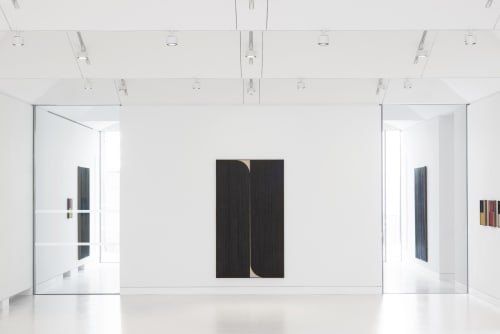VIGO is pleased to announce our fourth solo show with Johnny Abrahams to be held at the Pavilion at Cromwell Place from 17-23 May 2021. The artist has developed a new body of work over the last year, holding back the most significant paintings for this exhibition, his first in London for two years. The paintings have taken on a more pronounced physical presence whilst retaining their subtlety and seduction.
“The best way for me to organize my thoughts on this work is to make a series of analogies to various modes of musical composition. A surprising amount of reductive artists have a strong understanding of musical structure and have at some point, in some way, studied musical composition, myself included.
Something about the order and boundaries, and the deliberate and wilful variation/deviation of these boundaries provides a suitable framework for certain types of abstraction. One example that comes to mind is Sol Lewitt’s use of the grid as a guiding structure in light of his interest in Bach’s compositions, with the grid mirroring the division of the octave into twelve equal semitones. The grid becomes the organizing principle for an art of serial variation, a means of “ordering the inchoate messiness of reality.
The idea that art as a reality organizing activity can be based on fundamental structures (e.g., a predetermined set of musical intervals or a structured grid) is compelling to me, and much of the drama in these paintings can be experienced in how they both reference and avoid these structures.”
Deceptively simple, these paintings present a unique vocabulary of satisfying meditative shapes, built up and refined over years and combined alongside colour and texture to play strongly with the negative space of the raw canvas.
The relationships between the symbols that are Abraham’s alphabet are dependent on nothing other than themselves. There is a musicality to the compositions as they convey rhythm, phasing, and cadence with an unmistakable melodic character. In series they intend to set the viewer up with both theme and variant, creating a simultaneous sense of comfort and dissonance, hinting at a never realized pattern.
“These paintings have a power that is difficult to locate, but I would like to suggest that the source might stem somewhere from what the viewers have been set up to expect. It’s as if the composition were some sort of snapshot taken in the middle of a phased melody with the listener unsure if the two parts have just started echoing, have moved far enough to double each other, descended into chaotic ringing, or are headed back almost toward unison. “
The composition of each painting seems to be a snippet of an overall pattern the viewer has only partial access to, suggesting a melody and then deviating from it, setting up a resolution and then arriving at an unexpected note. Balance without symmetry. The forms within the compositions and the variations between individual paintings are experienced in the way microtones are experienced by a musician using a twelve-tone scale. The shapes seem familiar but slightly askew and perhaps closer than expected. But it is this particular moment of subtly where the tension and drama are created in the paintings.
The cramped compositional tension is expanded by the most recent use of colour. Some of these latest paintings are two-toned placed side by side so that the use of colour and shape reflect and reinforce each others subtlety. That is to say the colours are proximate to one another on the spectrum in a similar way to how the shapes relate to each other in the composition. This could be seen as a scale with its own intervals through which the work has been composed.
“Whether it be musical notes or grids, the idea of art as a reality organizing activity is fundamental to my practice. However, these compositions seem less a way of ordering reality than a way of simply drawing attention to it. The work invites meditation, but not a passive meditation with the goal of calming and soothing the viewer into complacency. It’s an active meditation that challenges the viewer to question the social construction of categories and borders” -Johnny Abrahams 2021
Toby Clarke - May 2021


